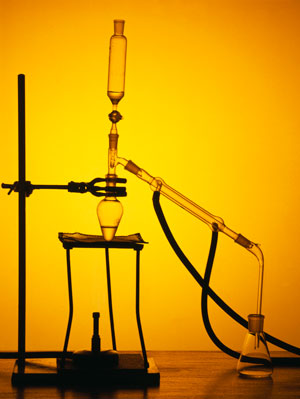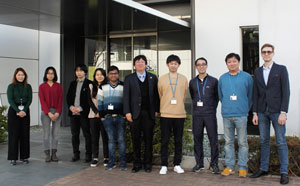Feb. 28, 2020 Research Highlight Chemistry
A highly active and robust solid catalyst provides high yields of esters by continuous flow
A small change in the chemical structure produces a big improvement in performance for a continuous-flow catalyst
 Figure 1: Going back to high-school chemistry enabled RIKEN chemists to develop a catalyst that can produce esters at high yields in a continuous-flow process. © ANDREW LAMBERT PHOTOGRAPHY/SCIENCE PHOTO LIBRARY
Figure 1: Going back to high-school chemistry enabled RIKEN chemists to develop a catalyst that can produce esters at high yields in a continuous-flow process. © ANDREW LAMBERT PHOTOGRAPHY/SCIENCE PHOTO LIBRARY
Recalling basic textbook chemistry has enabled RIKEN researchers to develop a better solid catalyst for producing important industrial chemicals known as esters1. This advance promises to benefit the manufacture of fuels, pharmaceuticals, resins, paints, adhesives and perfumes.
Esters form in the chemical reaction between the hydroxyl (OH) group of alcohols and the carboxyl (COOH) group of carboxylic acids. When these groups combine, a water molecule (H2O) is released, leaving the remainder of the alcohol and carboxylic acid molecules bound together as an ester. Many school students perform this simple reaction during their first introduction to organic chemistry.
Although esters can easily be made in low yields, it is challenging to produce them at the high yields needed by industry. “Achieving the complete conversion into esters is difficult,” notes Yoichi Yamada of the RIKEN Center for Sustainable Resource Science. Esterification is an equilibrium reaction—one that settles into a state where both the forward and reverse reactions proceed at the same rate. The challenge is to minimize the reverse reaction so that the production of ester dominates.
Yamada and his colleagues met the challenge by remembering their school textbooks. “We were surprised to find that knowledge from beginner organic chemistry courses helped us to develop a new cutting-edge catalyst,” he says.
 A team led by Yoichi Yamada (sixth from the left) has developed a highly active and robust solid catalyst that provides high yields of esters in continuous flow esterification. © 2020 RIKEN
A team led by Yoichi Yamada (sixth from the left) has developed a highly active and robust solid catalyst that provides high yields of esters in continuous flow esterification. © 2020 RIKEN
Basic chemical theory says that a small change in the relative positions of two groups bonded to a ring of six carbon atoms can greatly affect a molecule’s stability. This inspired the researchers to modify the placement of the groups they had used in an earlier but unstable version of their catalyst. Changing the structure of the key starting material produced a solid catalyst that is more stable, more active, reusable and robust.
This new catalyst has the great advantage that it can work under continuous flow conditions. The alcohol and carboxylic acid are pumped into a column packed with the catalyst powder, allowing high yields of the desired ester to flow out from the other end. This process outperformed other commercial catalysts in trials producing an ester-based biofuel. In addition, the catalyst is mass producible so that it can be manufactured on the large scales needed by industry.
Yamada believes that the catalyst could eventually significantly impact the chemical industry. “All companies that produce organic chemicals should be interested,” he comments.
The RIKEN team is now seeking to extend the usefulness of their catalyst by exploring other reactions that it could be used for.
Related contents
- Scientists recalculate the optimum binding energy for heterogeneous catalysts
- Doubling down on boron to make complex organic molecules
- Open sandwich catalyst creates chiral silane molecules
References
- 1. Hu, H., Ota, H., Baek, H., Shinohara, K., Mase, T., Uozumi, Y. & Yamada, Y. M. A. Second-generation meta-phenolsulfonic acid−formaldehyde resin as a catalyst for continuous-flow esterification. Organic Letters 22, 160–163 (2020). doi: 10.1021/acs.orglett.9b04084
